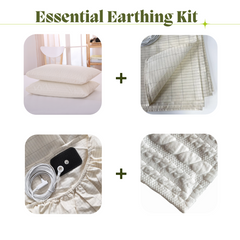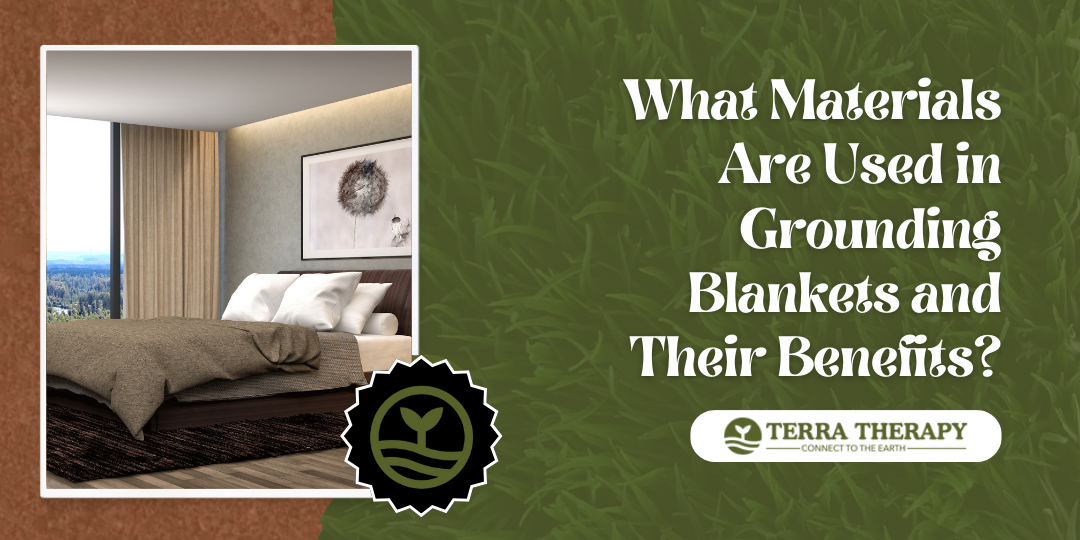Have you ever wondered why a good night's sleep, free from bed pain, discomfort, and body heat, feels so elusive? The answer, content with tools addressing body heat and discomfort, might lie in the fabric of your bedding.
These innovative blankets, tools in the fight against discomfort, harness conductive fabrics, promising not only improved sleep quality but also numerous health benefits, including reduced stress and inflammation, as well as changes in services related to health management.
Dive into the world of grounding blankets and explore how swapping out your regular blanket for one infused with grounding technology could be the key to unlocking unparalleled relaxation and well-being.
Key Takeaways
- Conductive Fibers: Grounding blankets are made with conductive materials like silver or carbon fibers, which enable the transfer of the Earth's electrons to the body.
- Health Benefits: These materials help reduce inflammation, improve sleep quality, and decrease stress levels by connecting users to the Earth's natural energy.
- Durability and Comfort: High-quality materials ensure that grounding blankets are both durable and comfortable for everyday use.
What Materials Are Used in Grounding Blankets and Why?
Conductive Fibers
Grounding or earthing blanket incorporates conductive fibers to connect with the Earth. These fibers are typically made from silver or carbon. They effectively conduct the Earth's electrons to the user.
Silver stands out for its antibacterial properties, making it an excellent choice for maintaining hygiene. Carbon, on the other hand, is praised for its durability and conductivity. Both materials ensure that grounding blankets reduce stress and improve sleep by mimicking the natural electrical exchange between the human body and the Earth.
Fabric Blend
The base material of an earthing blanket often involves a blend of cotton and polyester. This combination provides comfort while ensuring durability. The cotton part of the blend offers a soft touch against the skin, enhancing user comfort during sleep.
Polyester adds strength to the fabric, extending the lifespan of the grounding blanket. This blend supports the conductive fibers, ensuring they remain effective over time.
Connection Kit
Each grounding or earthing blanket comes with a connection kit. This includes cords and grounding rods or mats designed to link the blanket directly to the Earth's surface. The kit ensures that users can easily set up their blankets to enjoy the benefits of grounding, such as improved sleep quality and reduced inflammation.
Why Material Choice Matters in Grounding Blankets?
Conductivity Levels
The effectiveness of grounding blankets hinges on their conductivity. Materials with high conductivity ensure a seamless flow of electrons from the body to the Earth. This process is crucial for reaping the full benefits of grounding, including improved sleep and reduced inflammation.
Silver and carbon are often integrated into grounding blankets to enhance this conductivity. They allow users to connect more efficiently with the Earth's natural electrical field.
Durability Factor
Grounding blankets need to withstand regular use and washing. The choice of material directly impacts their longevity and maintenance ease. Durability is not just about lasting long but also maintaining effectiveness over time.
Fabrics that blend conductive threads with solid and natural fibers offer an optimal balance. They ensure the blanket remains effective after multiple washes, providing sustained health benefits.
Comfort Consideration
Users spend hours wrapped in grounding blankets, making comfort a top priority. The material should be soft, breathable, and skin-friendly. It influences user experience significantly, encouraging regular use, which is critical to obtaining long-term health benefits.
Breathable materials like cotton mixed with conductive fibers perfectly balance comfort and functionality. They keep the user cool while ensuring efficient grounding.
When to Consider Different Materials for Grounding Blankets?
Choosing the suitable material for grounding blanket with benefits is crucial for their effectiveness and durability. Cotton, polyester, and conductive threads are standard materials. Each serves different needs based on the environment they're used in.
For indoor use, cotton grounding blankets are a top choice. They offer comfort and breathability, making them ideal for sleep or relaxation. Their natural fibers ensure a gentle touch against the skin, enhancing the grounding experience.
In contrast, outdoor activities or harsher environments call for polyester grounding blankets. They're known for their durability and resistance to moisture. This makes them suitable for camping or use in damp conditions where cotton might also not hold up.
Conductive threads woven into grounding blankets are essential for their functionality. These threads connect the blanket to the Earth's energy, providing the benefits of grounding. When selecting a blanket, ensure it has a high content of these conductive materials. It guarantees better conductivity and enhanced grounding effects.
It's also important to consider personal sensitivities. Some individuals may find certain materials irritating to their skin. In such cases, opting for hypoallergenic materials can significantly affect comfort.
Where to Find High-Quality Materials for Grounding Blankets?
Finding the best grounding blanket involves knowing where to source high-quality materials. Specialty online retailers often offer a wide selection of grounding blankets designed with health and wellness in mind. They focus on products that promote better sleep and reduce stress by utilizing conductive fabrics. These retailers typically provide detailed product descriptions, ensuring buyers understand what makes their offerings stand out.
Local health and wellness stores are another excellent place to look. They might carry fewer options than online platforms but often stock products from trusted, reputable brands. Staff at these stores can offer personal insights and experiences, adding valuable information to your search.
For those interested in crafting their grounding blankets, fabric stores selling conductive textiles are worth exploring. These fabrics can include silver thread or carbon-based materials, essential for creating a practical grounding effect. However, it's crucial to research and ensure the quality of these materials before purchasing.
Manufacturers dedicated to electromagnetic field (EMF) protection gear also produce some of the best grounding blankets available. Their products are usually backed by scientific research and certifications, providing peace of mind for users concerned about EMF exposure.
- Specialty online retailers
- Local health and wellness stores
- Fabric stores for DIY projects
- Manufacturers specializing in EMF protection
Each option offers benefits, from personalized advice at local stores to a vast online selection. By carefully considering where to find these materials, individuals can ensure they choose a grounding blanket that meets their specific needs and preferences.
How Material Selection Impacts Grounding Blanket Comfort and Effectiveness?
The material of a grounding blanket for a bed plays a crucial role in its comfort and effectiveness. Silver thread is often incorporated due to its excellent conductivity. This allows the blanket to ground you, effectively reducing stress and improving sleep quality. However, the type of fabric surrounding the silver threads also matters. Natural fibers like cotton or bamboo are breathable and soft, enhancing comfort during use.
Choosing a suitable material affects how well the grounding blanket works. For instance, synthetic fabrics may hinder grounding because they do not conduct electricity or natural materials. They can also trap heat, making you uncomfortable at night.
It's essential to find a balance between conductivity and comfort. A high-quality grounding blanket will have enough conductive material to ensure adequate grounding while being encased in a comfortable fabric that promotes good sleep hygiene.
Remember, the source of your grounding blanket's materials matters too. As discussed in the previous section on finding high-quality materials, sourcing from reputable suppliers ensures that your blanket is effective and safe. They provide materials that strike the perfect balance between conductivity for grounding purposes and comfort for a good night's sleep.
What Natural and Synthetic Materials Offer in Grounding Blankets?
Grounding blanket come in various materials, each with unique benefits. Natural fibers like cotton and wool are breathable. They keep users cool in summer and warm in winter. These materials also have a soft feel, enhancing comfort during use. However, they may require more care in cleaning and maintenance.
On the other hand, synthetic materials such as polyester offer durability and ease of care. They resist wrinkles and stains better than their natural counterparts. Yet, they might provide a different level of breathability or comfort.
Both materials can effectively conduct Earth's electrons when incorporated with conductive threads like silver or stainless steel. The choice between natural and synthetic materials largely depends on personal preferences regarding comfort, care, and sensitivity to certain fabrics.
It's important to note that the effectiveness of a grounding blanket is not solely determined by its material but also by how well it connects to the Earth's energy. Proper grounding requires direct contact with the skin and a connection to the ground outside or a grounded outlet inside.
In choosing between natural and synthetic materials for a grounding blanket, consider your specific needs for comfort, care, and conductivity. Both options offer unique advantages that can enhance the grounding experience.
How to Choose the Best Material Combination for Your Grounding Blanket?
Selecting the suitable material for your earthing blanket involves understanding the unique benefits of both natural and synthetic fibers. It's crucial to strike a balance that meets your comfort, durability, and practical grounding needs.
Natural materials like cotton and wool are breathable and comfortable. They ensure a good night's sleep by regulating temperature effectively. However, they might not be as durable as synthetic options. On the other hand, synthetic fibers, such as polyester, offer longevity and are often more affordable. Yet, they may provide a different level of comfort or breathability than natural materials.
For optimal performance, a blend of both types might serve you best. This combination can leverage the durability of synthetic materials while maintaining the comfort and grounding effectiveness of natural fibers.
Consider your personal preferences, too. If you have sensitive skin, a higher proportion of natural materials in your grounding blanket might be preferable. For those prioritizing ease of care and affordability, synthetics could be more appealing.
Remember to check for any added conductive threads or technologies integrated into the blanket. These enhancements can significantly improve its grounding capabilities.
Why Antimicrobial Properties Are Valuable in Grounding Blanket Materials?
As discussed, choosing a suitable material for your grounding blanket is crucial. However, an aspect that often goes unnoticed is the importance of antimicrobial properties in these materials. Grounding blankets, designed to enhance physical and emotional well-being by connecting you to the Earth's energy, are in direct contact with your skin for prolonged periods. This makes them susceptible to bacteria and other microbes.
Antimicrobial properties prevent the growth of bacteria, mold, and mildew on the blanket. This is not just about cleanliness or odor control; it's about health. Bacteria and mold can cause skin irritations and allergies. For individuals with sensitive skin or respiratory issues, these problems can become severe. Therefore, a grounding blanket with antimicrobial features offers extra protection against these potential health hazards.
Moreover, grounding blankets with antimicrobial materials tend to have a longer lifespan. They resist deterioration from microbial growth, ensuring the blanket maintains its integrity and effectiveness over time. For those investing in the grounding blankets for their health, choosing one with antimicrobial properties ensures durability alongside wellness benefits.
Conclusion
Selecting the best grounding blanket involves understanding the intricate balance between materials and their properties. Your choice directly influences comfort, effectiveness, and health benefits, making it crucial to opt for high-quality materials that align with your needs.
Whether you lean towards natural fibers for their breathability and eco-friendliness or synthetic ones for durability and antimicrobial features, the key is prioritizing what matters most to you. Remember, the suitable material enhances your grounding experience and ensures longevity and satisfaction in your investment.
As you embark on this journey to find your ideal grounding blanket, consider these insights as a guide to making an informed decision. Dive deeper into the specifics of each material and how they contribute to a grounding blanket's overall performance.
Your well-being is paramount, so choose wisely. Are you ready to take the next step? Explore our collection today and experience the transformative power of a well-chosen grounding blanket.





